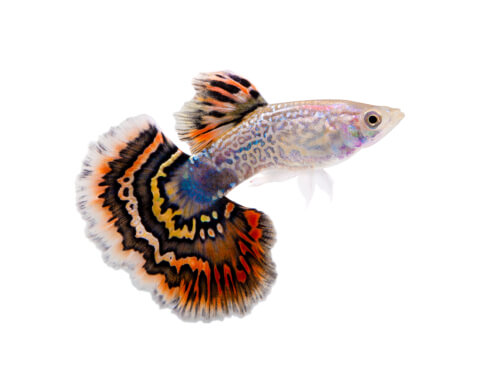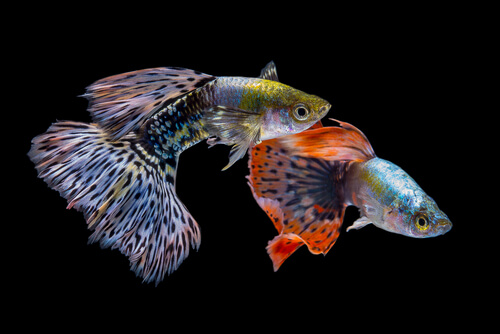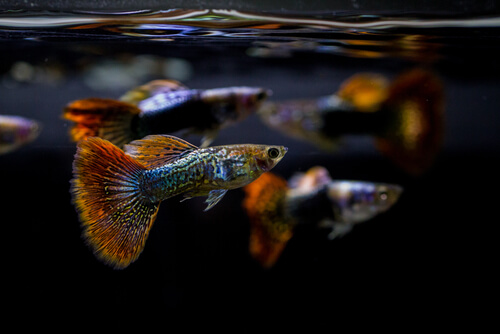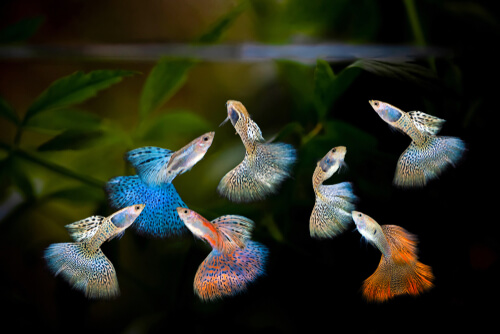
| Kingdom | Animalia |
| Phylum | Chordata |
| Class | Actinopterygii |
| Order | Cyprinodontiformes |
| Family | Poeciliidae |
| Genus | Poecilia |
| Species | Poecilia reticulata |
| Niche | Aquatic fish |
| Length | 0.6-2.4 in (1.5-6 cm) |
| Lifespan | 2 years |
| Social Structure | Schooling |
| Conservation Status | Least Concern |
| Preferred Habitat | Small freshwater streams |
| Average Brood Size | Highly variable, dependent on age, size, environmental factors |
| Main Food Items | Algae, plant debris |
| Predators | Larger fishes, birds |
The Basics
The guppy is a small tropical fish originating in South America and is now found throughout the world. It is also one of the most popular species kept in freshwater aquariums. Males are known for their colorful and ornate caudal and dorsal fins and the species is commonly used as a model species in various fields of research such as ecology and evolution.
Description
The guppy is a small fish. Males are significantly smaller than females, measuring just 0.6-1.4 in (1.5-3.5 cm) long. Females, at about 1.2-2.4 in (3-6 cm) in length, are about twice the size. Males also tend to be more colorful, and extravagant, with ornamental fins absent in the females.

Due to their popularity as a freshwater aquarium species, captive guppies have been subject to a significant amount of selective breeding. This has led to the production of various strains, distinguished by their colors, shapes, sizes, and patterns. Wild guppies are generally not as colorful as these domestic varieties and tend to be smaller.
Guppy Range and Habitat
Originally described in Venezuala and Barbados in 1859 and 1861, respectively, the species is native to many other Caribbean countries and countries in northern South America. They are a tropical species, confined to warm environments relatively near the equator. Since their discovery, they have been introduced to many parts of the world and are now common on all continents besides Antarctica.
Guppies have colonized virtually all freshwater habitats available to them in their natural range. In particular, they are abundant in streams in coastal regions. They tend to inhabit smaller streams and pools within this range over larger bodies of water. This even includes brackish, highly saline waters where they are not typically found but have indeed managed to colonize and inhabit. Much like the molly (Poecilia shphenops), a closely related fish that prefers saltwater habitats, guppies can acclimate to saltwater habitats where necessary.
Diet and Predators
In the wild, the guppy feeds on a variety of items such as algae and detritus. They will also consume mineral particles and small invertebrates such as minuscule shrimp-like animals. They also feed on insects such as mosquitoes, particularly their larvae that are often laid in the waters where guppies live. Guppies will often forage for food in groups, using a collective system to alarm each other of any predatory threats. This allows each individual to be able to spend more time feeding and less time scanning for predators.
As small fishes themselves, guppies are subject to predation by many species. Larger fishes, of course, will readily eat guppies of all sizes. A common species that preys on guppies in the wild is the blue acara (Aequidens pulcher). Many birds will also prey on guppies.
Reproduction
In the wild, guppies are highly productive, with females birthing 2-3 generations of young every year. Unlike many fish species which lay eggs, guppies are live-bearing, giving birth to young fish that are independent of parental care from the instant they are born. Young guppies will form schools to evade predators. However, being so small, they are of course very vulnerable.

Females will mate with multiple males during each breeding season, a mating strategy known as ‘polyandry’. They will even delay the development of their brood if subsequent mates are more attractive than her first partner. Females can store the sperm of males for up to 8 months in their ovaries and gonoducts. Normally, the gestation period for each brood is about 3-4 weeks but varies considerably with environmental factors such as temperature. Females
At about 10-20 weeks of age for females and just 7 weeks for males, these offspring will be sexually mature themselves. Guppy lifespan depends highly on environmental factors such as the amount of predation they are subject to in their particular habitat but is typically only about 2 years in the wild.
Fun Facts about Guppy!
With the guppy being present in almost every continent and a highly popular species for scientific studies and home aquariums, there is no shortage of fun facts to learn about the species.
The Great Mosquito Colonizer
You may wonder how the guppy – a relatively small and not overtly fascinating fish at first glance – made its way throughout the natural world and into the aquariums of millions. Indeed, much of the introduction of the species occurred by accident, perhaps through poorly managed ship ballast water which can transport species and their larvae across oceans to novel habitats. However, in many parts of the world, the guppy was introduced intentionally as a means of pest control.
Indeed, guppies were introduced by governments in well-intentioned but usually futile and often catastrophic attempts to control local mosquito populations and their associated diseases such as malaria. However, as has been observed on many occasions where non-native species are introduced to new habitats, there were unintended ecological consequences to this. The guppy lives in virtually all freshwater habitats made available to it in areas where it has been introduced. This is great news for the guppy species itself. However, this high level of adaptability means that guppies have outcompeted native fish in many of these habitats to which they have been introduced.
Sexual Dimorphism in the Guppy
Sexual dimorphism is quite well understood and recognized in birds. Males are often very colorful and extravagant and develop habits and behaviors such as courtship dances that accentuate these features. However, this phenomenon of distinct physical appearances between species is common throughout the animal kingdom and occurs in fishes – including the guppy.

Females play a significant role in maintaining male’s extravagant fins and colors. They are attracted to the more brightly colored males – particularly those with orange spots on their flanks. This puts selective pressure on male guppy populations, typically favoring those with orange spots as it may be an indicator of their foraging ability and overall health. However, in the wild, this bright coloration can also make males more prone to being seen by predators and eaten, so it is a trade-off from an evolutionary perspective. Males will also perform courtship displays reminiscent of many birds, sometimes flexing their bodies into an S-shape and vibrating rapidly with their elaborate fins fluttering in the current.
A Model Specimen
Largely due to their low mortality rates in captivity, the guppy has been widely used as a model species for studies in ecology, evolution, and more. Interestingly, guppies have 23 pairs of chromosomes, including a pair of sex chromosomes. This is the same as in humans, making them obvious candidates for studies in genetics with implications for human health as well.
Variations between guppy populations in areas with different environmental stresses and pressures have shown that their life history will adapt to the conditions in which they exist. For example, guppies in areas where there are more threats from predators will spend more of their time and energy on reproducing young. They will mature faster and start reproducing earlier than guppies in areas without predators. They will also reproduce more frequently and with larger brood sizes than guppies that face fewer environmental stressors.
